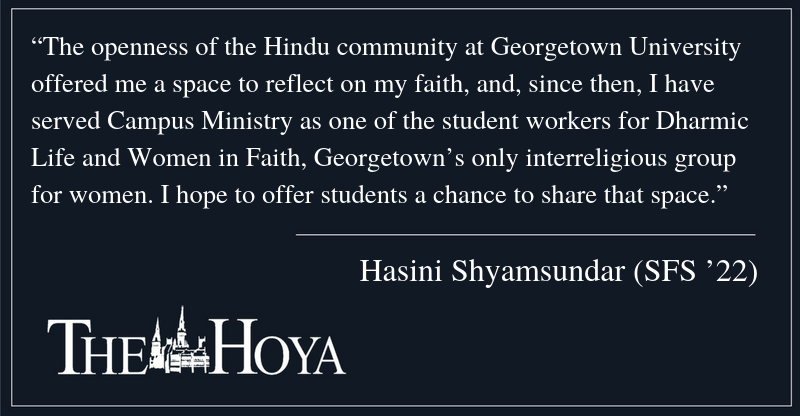The first time someone asked me if I was a “Hindi,” I felt a heaviness in my chest. I felt it come back when I walked into a department store and saw T-shirts with “Namastay in Bed” and “Namaslay” printed on them. That heaviness grew every time I saw Indian American characters portrayed on television laughing along as their friends poke fun at their cow-worshipping tendencies.
When I was younger, I understood my traditions to be less developed, less coherent and less applicable to real life. Despite growing up in the San Francisco Bay Area, a region of the country brimming with Indian American pride and friends from Hindu backgrounds, I rarely saw Hindu traditions portrayed positively in mass media or entertainment.
Since coming to Georgetown University, I’ve worked past the stereotypes and misconceptions. I have found new sources of spirituality and the opportunity to explore them on my own terms. Now, I identify as Hindu without hesitation.
As a child, the rich history of Hindu traditions was distilled into simple mythological tales, each with their own black and white morality. My high school teachers taught me “Hinduism” was one of the few polytheistic religions still practiced today with a nonnegotiable belief in God. News articles tied Hindu traditions to strict, conservative attitudes and casteism, a system of social classification codified during the colonial period. There was no room for questioning or finding own path.
Historically, the legacies of Hindu traditions have been stripped of their Hindu identity. Some have monetized the ancient practice of yoga, marketing it as exercise and erasing its spiritual origins. Meditation has been rebranded as “mindfulness” with its cultural roots blurred, people claiming to have found the cure for anxiety and depression. As these legacies became increasingly separated from their Hindu past, I resigned to accepting my fate as a follower of a cow-worshipping, ritualistic tradition. I was so deeply disconnected from reality that I eventually abandoned identifying as Hindu altogether.
It wasn’t until I arrived at Georgetown that I realized my previous perceptions of Hindu traditions were actually misperceptions. When I sat down at my first Arati, a service of veneration through light, I learned nearly every aspect of Hindu traditions is open to discussion — including the nature and existence of God. When I meditated for the first time at Georgetown in a setting that didn’t commercialize meditation, I finally learned to connect with my body in the way “mindfulness gurus” had always described. When I sang “Om Jai Jagdish Hare” in unison with the dozens of other members of the Georgetown Hindu community, I felt my formerly empty chest fill with a warmth I had never felt before.
While the majority of my formerly Hindu-identifying friends from home are now staunch atheists, still holding that Hindu traditions are what the media portrays them to be, I have had the opportunity to make religious dialogue part of daily life. The openness of the Hindu community at Georgetown offered me a space to reflect on my faith, and, since then, I have served Campus Ministry as one of the student workers for Dharmic Life and Women in Faith, Georgetown’s only interreligious group for women. I hope to offer students a chance to share that space.
Over time, I have learned that Hindu traditions are not less developed nor inconsistent — the complexities have been masked by centuries of oppression. Any contradictions that exist within different Hindu scriptures are the result of years of debate. Hindus traditions are both monotheistic and nontheistic, spiritual and philosophical. And they are certainly applicable to real life. Indeed, Eastern traditions do advocate for constant questioning of the status quo and the application of the scientific method to the realm of spirituality. Hindu traditions do not cultivate believers — they cultivate seekers.
Today, I consider myself one of the seekers. That means looking to the past to understand the present, realizing that translators of Hindu texts have frequently mistaken respect and consecration for worship, and that caste and inequality were impositions rather than features of the practice. Seeking means working to shape a better future, taking courses like “Religion in Modern South Asia” and engaging in interreligious dialogue with my peers. Because I am a seeker, my spirituality is not clear-cut — I can’t turn to a single text to explain my faith, but I have the opportunity to find answers on my own. That is liberating.
Hasini Shyamsundar is a sophomore in the School of Foreign Service. Interfaith Insights appear online every other Wednesday.














